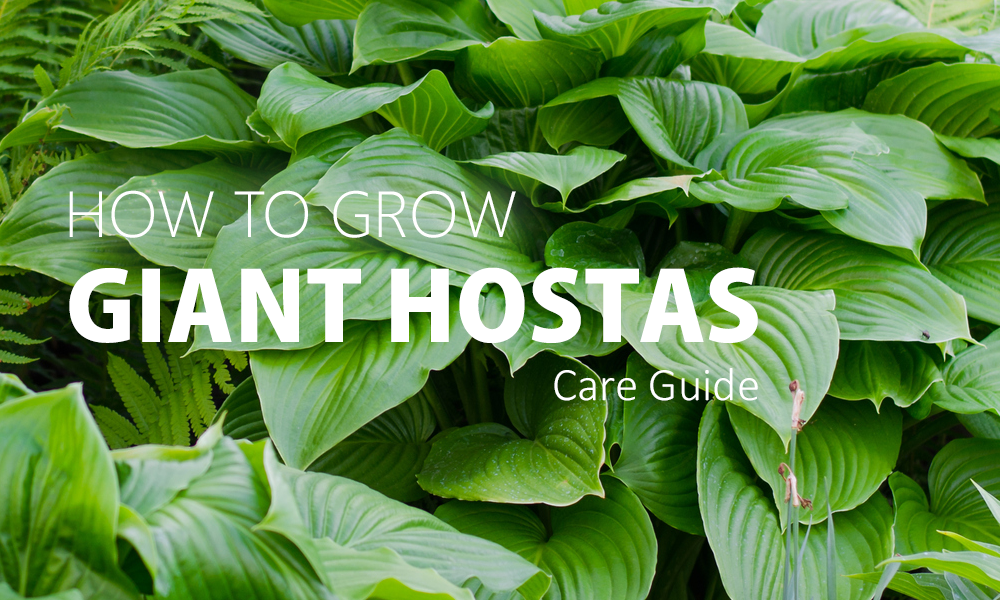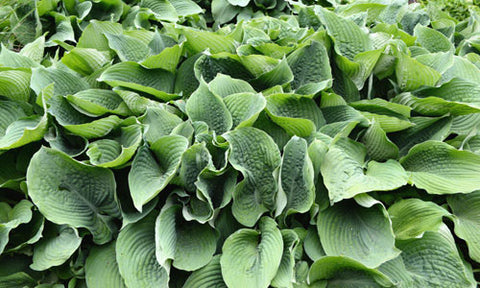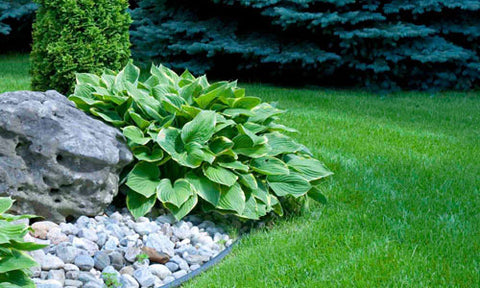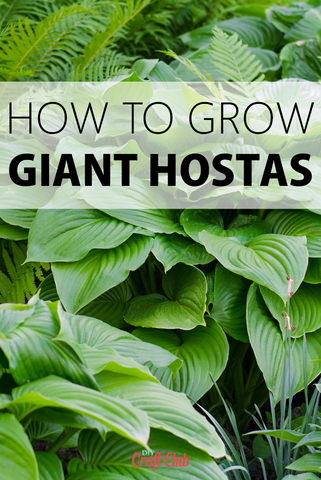Welcome!

Here is how to grow really large hosta plants for your shade garden.
If you are looking for the best way to grow the largest hostas in the neighborhood you have come to the right place.
Do you love the look of large hosta plants but don't know how to grow them successfully? If so, you're in luck.
In this blog post, we will share with you some tips on how to grow large hosta plants. Keep reading for more information.

As hostas mature, they get larger and larger as long as they have ideal growing conditions.
A hosta matures in about 5 years and what a glorious sight. If you see a hosta that is huge, it's most likely over 4 years old.
With each year, the root system has a chance to really grab and work its way into the soil. That foundation creates the huge leaves that hostas are known for.
Hostas are a genus of plants that come from the family Liliaceae, and are closely related to lilies. There are thousands of different hosta varieties, so there is sure to be one that will thrive in your garden.

The most important thing is to plant the largest hosta varieties. Hostas come in many sizes. So if you are going for the plants that give you the massive leaves you are craving, you need to plant the species that are known for their large leaves and quicker growth rates.
There are over 70 species of hostas and thousands of varieties to choose from so this can be a challenging task.
Check with your local nursery to see what types they carry first because greenhouses and nurseries will carry the best varieties based on your growing location.
You can also order giant varieties online from many growers. You can even find large hosta plants here on Amazon.
Note: these sizes are approximate and can vary depending on growing conditions.

Hostas grow best when they have morning sun and afternoon shade. Hostas like lots of light but not direct sunlight on their leaves. Speckled light is best.
So the best place to grow a huge hosta is somewhere in your garden that has trees and shrub cover that will keep your hosta in and out of the sunlight throughout the whole day.
It's also preferred to have minimal sunlight during the later part of the day if possible.
When choosing a site to grow giant hostas be sure to think into the future about how big they will get. Make sure you leave enough room so that they aren’t too crowded by a tree or shrub.
The root systems need space too so keep that in mind when you are planting. Your hostas need good air flow to grow large healthy leaves.
The lighter the shade of the hosta plant, the more sun it can tolerate. Dark leafy hostas will do better with speckled light. Not many varieties can handle direct sunlight all day long.
You can grow potted hosta plants, just make sure the soil can drain and is rich in nutrients.

Remove all weeds, and loosen the soil so that the roots can easily spread. Add a layer of compost to the bed to help the plants grow.
Hosta plants do not tolerate drought well, so it is important to make sure the soil drains well to prevent the roots from sitting in standing water.
To improve drainage, you can add organic matter such as compost or well-rotted manure to the soil. You can also mix in a soil amendment like peat moss or perlite to help the soil drain better.

Once you have prepared the soil, dig a hole that is deep and wide enough to accommodate the root ball of your hosta plant.
Gently loosen the roots and place the plant in the hole, making sure that the crown (where the roots meet the leaves) is level with the soil surface.
Fill in the hole with the amended soil and water the plant well to help it get established.
Plant hostas in early spring. The best time to plant them is when the temperatures are cool and there is no threat of frost.
There are several reasons why it is best to plant a hosta in the spring.
First, spring is the traditional time for planting perennials, and hostas are a type of perennial plant. The cooler temperatures and consistent moisture of spring are ideal for establishing new plants, and the soil is often more workable at this time of year.
Planting in the spring also allows hostas to get a head start on the growing season, giving them time to establish their root systems and get established before the heat of summer arrives.

Additionally, spring is a good time to plant hostas because it allows them to grow and establish themselves before the onset of winter, when they will go dormant.
Rainwater Collection Barrels On Amazon
Your hosta will need plenty of water. People that grow huge hostas have one thing in common. They have a good water supply to keep large leafy hostas growing all season long. Especially during the hottest months of the summer.
Hostas thrive naturally in damp areas in Asia, so you have to try to mimic its natural habitat as best as you can.
So planting on a slope where natural rainwater will drain into the hosta or planting them near a rain gutter by the house is a great place to start.
Year after year you should start to see some significant leaf growth when planting your hostas in the right places in your yard or garden areas.

This doesn’t mean flooding your hostas! Just make sure they have a moist environment especially through the hot summer months of July and August. A good rule of thumb to grow giant hostas is that they need at least 1-2 inches of water every week.
Be diligent because if they lack the right amount of moisture and water, they will show stress and start to shrink while the plant starts to put all of the energy into keeping it's root system healthy.
If you are on water restrictions during the summer months, you might want to invest in a rainwater collector.
You can't just haphazardly throw plants into a garden area and expect the best results. And that is especially true for hosta plants.
To grow giant hostas you will need to start with good soil. Fluffy, deep, and rich soil full of nutrients will determine how large your hosta will be.
The better the soil, the healthier the root system and plant will be. Hostas have lots of delicate little feeder roots that spread out so they do not like hard, compact soil.

At least 12 inches deep of enriched soil and compost is good for your hosta plants but even more is ideal.
You can start by digging a hole about 1 foot deep by 1 foot wide and filling it with a layer of compost, then newspaper, then organic soil, then compost again. Plant your hosta and then mulch around it to keep the moisture in.
Hosta foliage need organic compost to thrive. You can give them a boost of compost at the end of the season and then again just as they are coming back up in the spring.
You can make your own compost very easily throughout the year with an under the sink composter. Mix the compost into the existing soil carefully so that you are not disturbing the roots.
This is the Vitamix electric composter
PH testing will tell how you how much acidity is in your soil.
Hostas grow the best when the soil ph level is at 5.8-6.5. If you have high acidity, you can add more organic matter to your soil to get those levels down. On the other hand, if your acidity levels are too low, you can add lime.
Follow the manufacturer's directions because there are different concentrations of lime. Try to get dolomite lime if possible because it has both calcium carbonate and magnesium carbonate.
For you to know exactly what type of soil you have, you will need to test it. Amazon has a ton of soil testers.
Soil Testers: Check Prices On Amazon
Also, check your EC levels on a regular basis. An EC level is the measure of total dissolved salts in a solution. This influences a plant's ability to absorb water.
So monitoring the salinity will help keep you more educated and knowledgeable about what your hosta plant needs.
A hosta EC level should be at 1.5-2.5. If your EC levels are too high, you can add more water to get the levels down and if you need a higher EC level, add more fertilizer until you see the numbers at optimal levels.
EC testers: Check Prices On Amazon

Mulching around the hosta leaves and allowing the mulch to rot year after year will help keep your hostas soil in good condition. And also keep it moist underneath the mulch. Hosta plants love this so much.
To keep your hosta plants moist with mulch, see if your local tree care companies are in your area, they might just drop off some mulch. Check with your local garden center or greenhouse. Grass clippings are a great mulch too.
Hostas really get huge when given a liquid fertilizer at 50-100 ppm nitrogen. Check your local greenhouse for the best one to use for your location. If you can’t be there to feed your hostas throughout the growing season or need to give them a boost, then you can feed them a slow release fertilizer vitamin boost.
These all-purpose EarthPods help stimulate root growth and enhance leaf color and all you have to do is push them into the soil near the center stem and then water as usual.
Feed your hosta plants when they are just starting to emerge in the spring and then again in 4 weeks and then give them one final boost right in mid-August.

Worms are the best little garden helpers! You can encourage worms by digging some holes here and there and burying compostable material throughout your garden.
Worms love newspaper and other garden waste. You know you have really great soil if you can see worms. Your hosta plants thrive in soil that has a healthy worm population.

Eggshells help with soil enrichment. Make sure you bash or grind them up so that they break down more quickly. Have a bucket of eggshells under the sink to collect.
Sprinkle them underneath the hosta leaves and into the dirt from time to time to make the soil even better. You can even make egg shell powder with a spice grinder which is even better.

If you want to grow seriously large hosta plants and hosta leaves then don't divide them. Hostas do not normally need to be divided, especially if you are going for huge leaves.
Dividing Your hostas will have the opposite effect so just leave them be and let them mature over the years.
Bees are essential pollinators, meaning they help flowers and plants to reproduce by transferring pollen from one flower to another.
Without pollinators, many plants would not be able to produce seeds and fruit, which could lead to a decline in the overall diversity and health of the ecosystem.
By attracting bees to your garden, you can help support the health of the plants in your garden and beyond. Try making your own DIY Bee bath to help attract these helpful insects.
Bees absolutely love the pale lavender colored hosta flowers.

Bees are a key part of the food chain and are vital to the health of the environment.
Many animals, including birds and small mammals, rely on bees and the insects they attract to provide a food source.
By attracting bees to your garden, you can support the health of these animals and the overall ecosystem.
In Conclusion:
It takes years for a hosta to grow truly huge! So keep it healthy and as the years go on, you will be rewarded with the biggest hostas on the block!
Thanks for reading and we wish you the very best in growing giant hostas this year! If you found this article helpful please Pin it.

MORE HELPFUL ARTICLES
Where To Buy Succulents Online
Comments will be approved before showing up.
